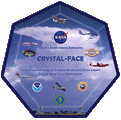The Far Infrared Sensor for Cirrus (FIRSC) is a remote passive airborne infrared spectrometer that uses Fourier transform spectroscopy (FTS) to measure the infrared radiance of cirrus clouds. FIRSC operates across two channels with a wavenumber range of 10-35 per centimeter and 80-135 per centimeter. It has a field of view of 0.03 radians, a footprint of less than one kilometer, and a scan time of 4 seconds.

Instrument Details
- Spectrometer/Radiometer
- Earth Science > Spectral/engineering > Infrared WavelengthsEarth Science > Atmosphere > Clouds > Tropospheric/high-level Clouds (observed/analyzed) > Cirrus/systems > Cirrus Cloud SystemsEarth Science > Spectral/engineering > Infrared Wavelengths > Infrared Radiance
- Troposphere
- 4 s
- <1 km
- 0.3-1 THz, 2.4-4 THz
- https://doi.org/10.1364/ao.40.002169
Currently unavailable
Currently unavailable
Currently unavailable
NASA
Unpublished
 Scaled Composites Proteus 4 Campaigns · 8 Instruments |  Chesapeake Lighthouse and Aircraft Measurements for Satellites 2001 Chesapeake Bay, Atlantic Ocean 1 Deployment · 5 Data Products
 Cirrus Regional Study of Tropical Anvils and Cirrus Layers Florida Area Cirrus Experiment 2002 Southern Florida 1 Deployment · 0 Data Products
|